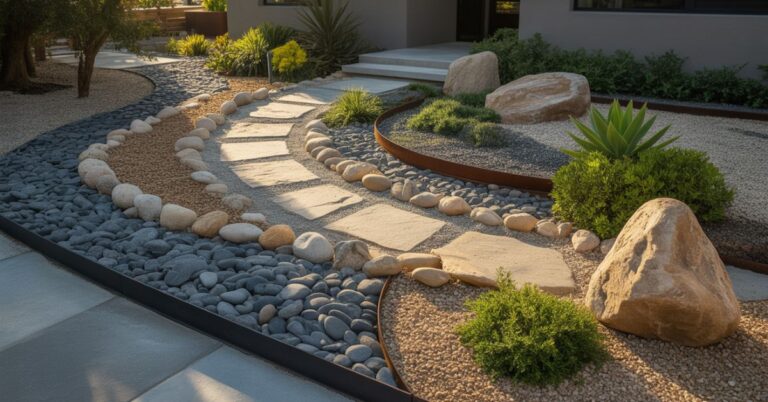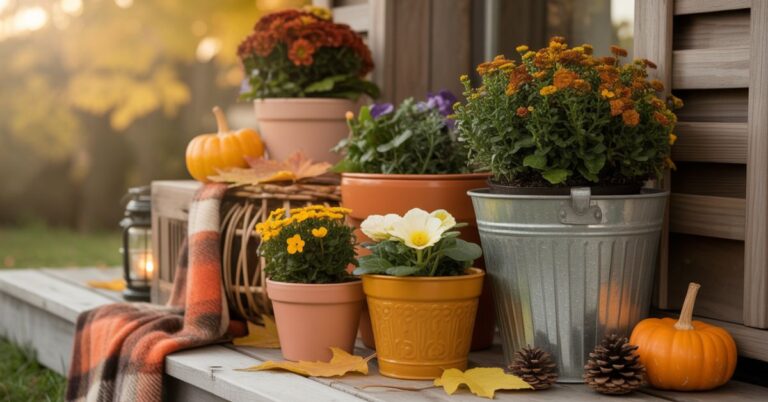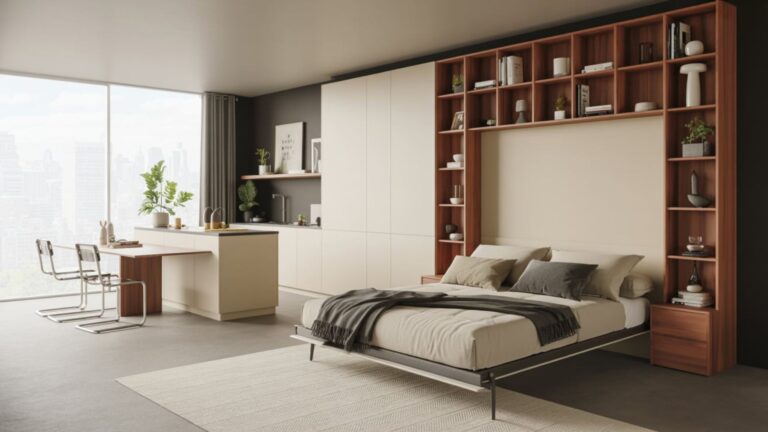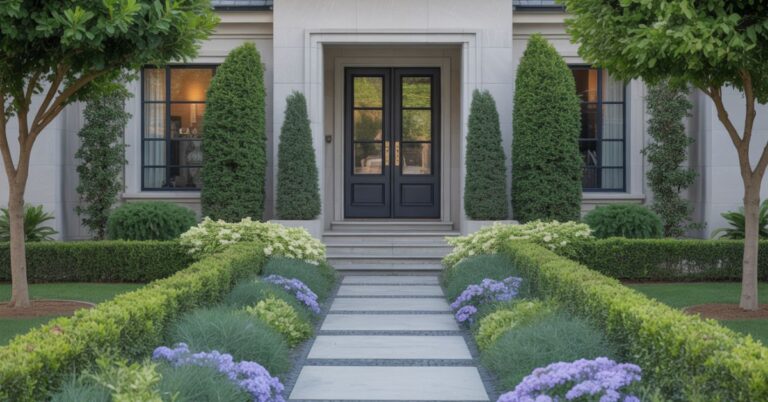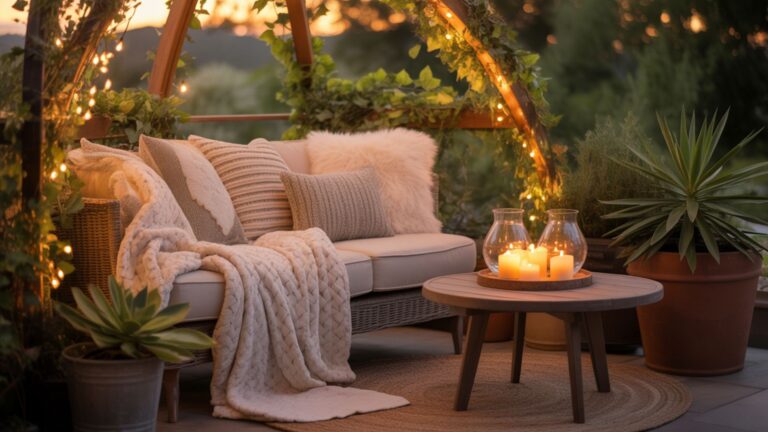Outdoor Patio Ideas with Pool Design a Luxurious Backyard Oasis
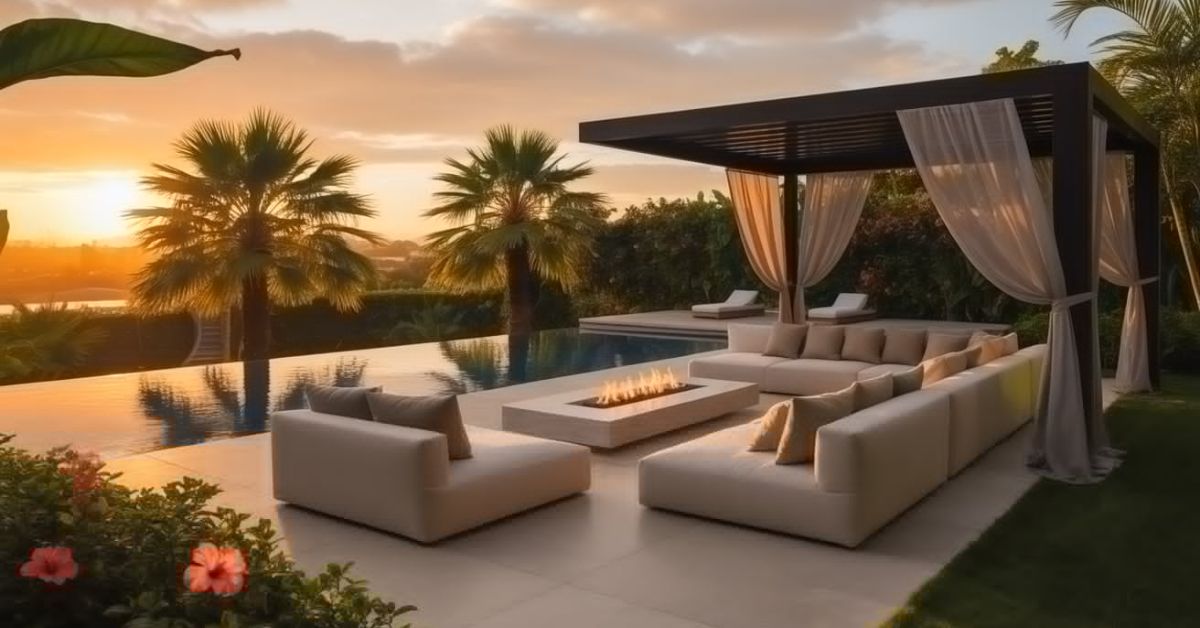
Your beautiful pool sits surrounded by boring concrete while Pinterest shows stunning poolside patio retreats that make you green with envy. That plain pool deck represents wasted potential for creating magazine-worthy entertaining spaces. Every summer day without a thoughtfully designed patio means missed opportunities for resort-style relaxation in your own backyard. The frustration grows when guests comment on your pool but nobody lingers because there’s nowhere comfortable to sit.
Here’s the relief you need: transforming your pool area with strategic outdoor patio ideas with pool integration doesn’t require celebrity budgets or complete renovations. Smart design choices, proper materials, and intentional layouts turn ordinary pool decks into extraordinary outdoor living spaces that make neighbors wonder if you hired a professional designer.
Why Poolside Patios Elevate Your Outdoor Experience
Outdoor patio ideas with pool integration create cohesive entertainment zones that maximize your property’s recreational value. Standalone pools function merely as exercise equipment while comprehensive poolside patio designs become lifestyle centerpieces.
Properly designed pool deck areas increase property values by 15-25% according to real estate appraisers specializing in luxury homes. Buyers pay premiums for move-in-ready outdoor living spaces that demonstrate thoughtful planning. Your investment pays dividends both in daily enjoyment and eventual resale returns. Beyond financial considerations, well-executed patio zones improve safety by clearly defining wet and dry areas.
Poolside patios extend usable seasons significantly compared to pools alone. While swimming becomes uncomfortable once temperatures drop, heated lounge areas with fire pits or outdoor fireplaces keep the space functional through fall and spring. You’ve essentially added another room to your home that happens to have spectacular water views. This expanded utility justifies the investment when you calculate cost per use over years.
How to Plan the Perfect Layout for Pool Patios
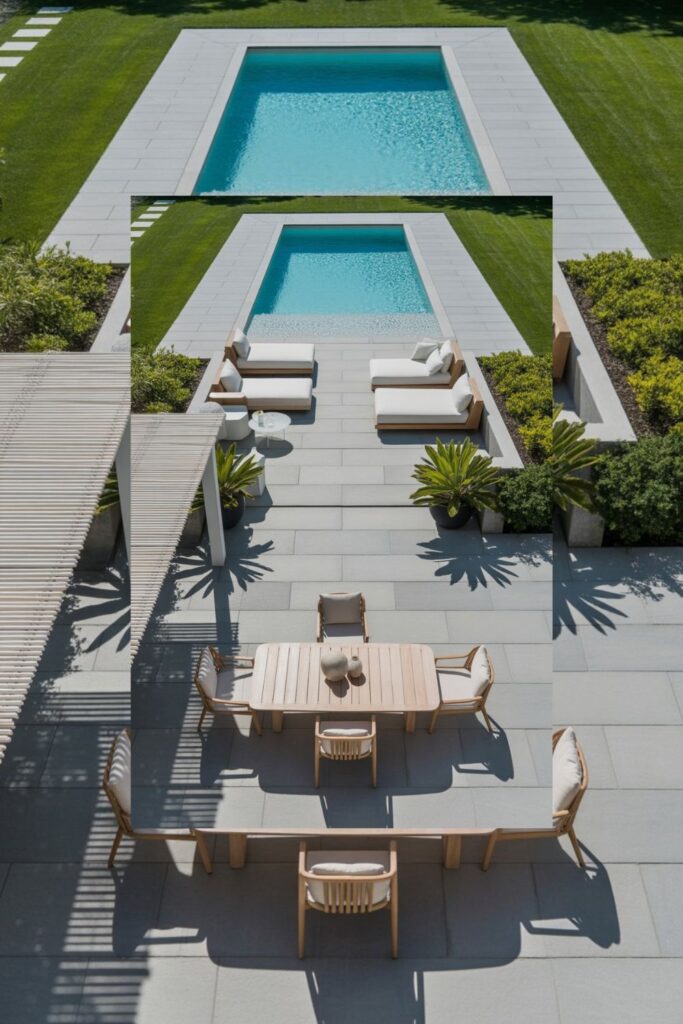
Pool deck ideas start with understanding traffic patterns and functional zones around your water feature. Successful poolside patio designs separate activities while maintaining visual flow.
Begin by identifying your pool’s primary access points from your home. French doors or sliding walls connecting to the pool area should align with wide patio sections that accommodate groups entering together. Avoid bottleneck pathways that force single-file traffic when carrying food or pool toys. A minimum 8-foot width works for high-traffic corridors while 4-6 feet suffices for secondary routes.
Lounge areas require positioning away from splash zones unless you want constantly wet cushions. Place comfortable seating 10-15 feet from pool edges where conversation happens without chlorine spray. These dry zones become reading nooks, cocktail spots, or shaded retreats for non-swimmers. Built-in benches with weatherproof storage underneath solve seating and organization simultaneously.
Sun and shade balance proves critical for all-day outdoor patio ideas with pool functionality. Morning sun bathers need eastern exposure while afternoon swimmers prefer western light. Create covered zones using pergolas, cabanas, or shade sails for guests wanting refuge from peak UV hours. Your patio should offer choices rather than forcing everyone into identical conditions.
Drainage solutions prevent water accumulation that creates hazards and damages surfaces. Grade patios with 1-2% slopes away from your home and toward drainage points. Install channel drains at pool edges to capture splash water before it reaches seating areas. Proper water management extends material lifespans dramatically while preventing slippery conditions.
Read More About: 27+ Outdoor Patio Ideas for Apartments
What Are the Best Materials for Pool Deck Patios?
Pool deck materials must withstand constant moisture exposure, chlorine contact, and barefoot traffic. Selecting appropriate surfaces impacts safety, comfort, and maintenance requirements for decades.
Non-slip surfaces top the priority list for poolside patio projects. Textured concrete, sealed natural stone, and specialized pavers provide traction even when wet. Avoid polished finishes or glazed tiles that become ice rinks after splashing. Test samples by pouring water and walking across them barefoot before committing to entire installations.
Travertine stone remains the gold standard for luxury pool decks because it stays naturally cool underfoot despite intense sun exposure. This limestone variety features beautiful neutral tones that complement any aesthetic. The material’s porous nature provides excellent grip while its calcium carbonate composition resists chlorine damage. Expect costs of $15-25 per square foot installed for premium outdoor living spaces.
Concrete pavers offer budget-friendly alternatives that still deliver professional appearances. Modern manufacturing produces pavers mimicking natural stone at half the cost. Permeable options allow water drainage through joints, reducing puddles and improving safety. Interlocking designs create stable surfaces that resist shifting better than traditional mortared installations. These versatile materials suit pool deck ideas ranging from contemporary to Mediterranean styles.
Composite decking has evolved specifically for poolside applications with enhanced moisture resistance and non-slip textures. Unlike wood that splinters, warps, or requires constant staining, composites maintain appearances with simple washing. Choose light colors that reflect rather than absorb heat for comfortable barefoot walking. Installation costs mirror premium pavers but reduced maintenance saves money long-term.
Pebble surfaces using exposed aggregate concrete create resort vibes while providing superior traction. Small stones embedded in the surface massage feet pleasantly and drain water efficiently. This technique costs slightly more than standard concrete but delivers distinctive character that plain surfaces lack. Seal properly to prevent stone loosening over time.
Outdoor Patio Ideas with Pool for Small Backyards
Small backyards with pools require creative patio solutions that don’t overwhelm limited space. Strategic design makes compact areas feel luxurious rather than cramped.
Integrated pool decks that serve multiple purposes maximize utility in tight quarters. Design one wider section as combination dining and sunbathing space using transformable furniture. Extendable tables accommodate meals then fold away for yoga or lounging. This flexibility prevents single-purpose areas that sit unused most days.
Vertical elements add functionality without consuming floor space in small backyards. Wall-mounted shelving stores towels, sunscreen, and pool toys within reach but off surfaces. Tall planters with tropical foliage create privacy screening while drawing eyes upward to make spaces feel taller. Trellises with flowering vines soften hard surfaces beautifully.
Cabana structures in corners provide shade, storage, and changing areas without sprawling footprints. Compact 8×8 foot designs include bench seating, hooks for wet suits, and mini-fridges for drinks. These hardworking features consolidate multiple functions into single architectural elements. Choose airy designs with open sides rather than enclosed boxes that make small backyards feel claustrophobic.
Minimalist patio furniture selections prevent visual clutter around pools. Four quality lounge chairs beat eight cheap ones that crowd circulation paths. Slim profile pieces in neutral colors disappear visually compared to bulky cushioned sets. Transparent acrylic or glass tables maintain sight lines while providing functional surfaces.
How Can You Create Shade Around Your Pool Area?
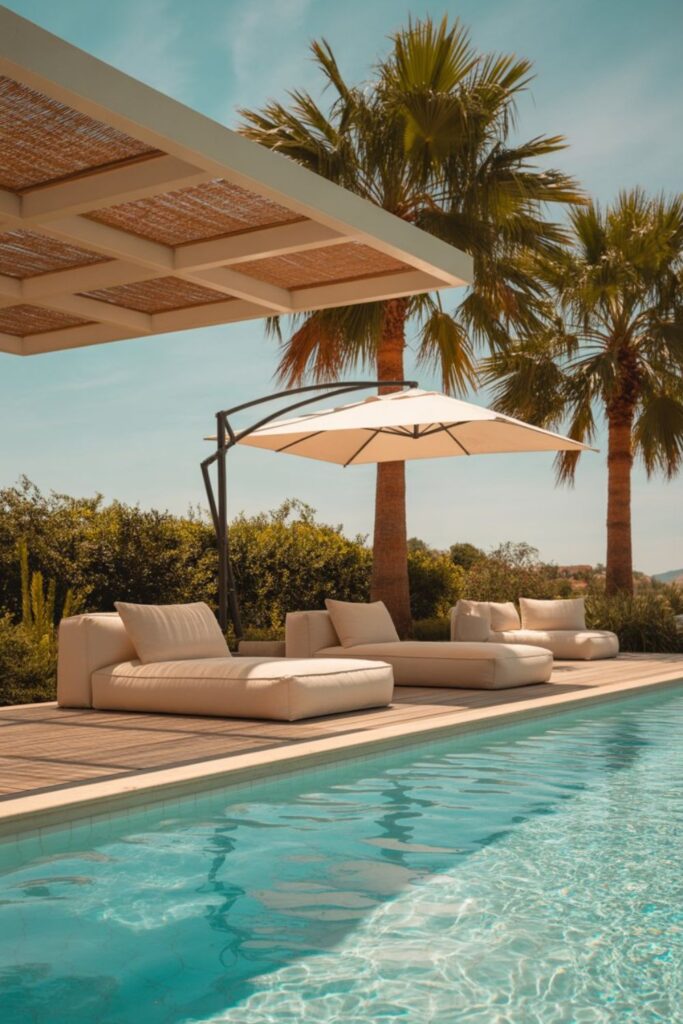
Shade structures transform scorching pool decks into comfortable all-day destinations. Unprotected poolside patios become unusable during peak afternoon hours without coverage.
Pergolas rank as the most popular shade solution for outdoor patio ideas with pool because they provide architectural interest beyond sun protection. Modern aluminum pergolas include adjustable louvers that rotate from fully open to completely closed as needed. These motorized systems operate via remote control or smartphone apps. Traditional wood pergolas support climbing plants that fill in over seasons for living shade that smells divine.
Retractable awnings offer flexibility that permanent structures can’t match. Extend coverage during hot afternoons then retract for star gazing at night. Quality awnings withstand wind and rain while lasting 10-15 years with proper care. Mount them to your home’s exterior or freestanding posts around pool perimeters. Automated sensors can trigger retraction during high winds for protection.
Shade sails create contemporary aesthetics perfect for modern pool deck designs. These tensioned fabric triangles or rectangles attach to posts at varying heights for dynamic visual interest. UV-resistant materials block 90-95% of harmful rays while allowing breezes through. Multiple sails in complementary colors turn functional coverage into art installations. Costs run $300-800 per sail including hardware and professional installation.
Cabanas and pavilions provide fully covered spaces for outdoor kitchens, bars, or lounge areas. These substantial structures require proper foundations and often need building permits. However, they add tremendous value by creating weather-protected zones usable even during light rain. Include ceiling fans or misting systems for active cooling beyond passive shade.
Living shade from strategically planted palms, river birches, or oaks delivers long-term solutions. Position trees considering mature canopy spreads to avoid roots damaging pool infrastructure eventually. Deciduous varieties allow winter sun while providing summer coverage. Fast-growing options like hybrid poplars establish shade within 5-7 years in most climates.
What Lighting Transforms Pool Patios After Dark?
Lighting design extends your poolside patio’s functionality hours beyond sunset while creating magical atmospheres. Layered illumination approaches work dramatically better than single floodlights.
Underwater pool lighting using LED fixtures creates stunning focal points visible from all patio areas. Modern color-changing systems cycle through hues to match moods or occasions. Position lights to highlight water features like fountains or spillways for dramatic effects. These submersible fixtures use low-voltage power for safety around water.
Ambient overhead lighting from string lights or pendant fixtures provides general illumination for outdoor living spaces. Drape café-style Edison bulbs along pergola beams or between posts for bistro charm. Space bulbs 18-24 inches apart for even coverage without harsh shadows. Solar options eliminate wiring challenges though brightness doesn’t match hardwired installations.
Path lighting embedded in pool deck surfaces guides foot traffic safely after dark. Low-profile LED fixtures mount flush with pavers to prevent tripping hazards. Space them every 6-8 feet along circulation routes and stairs. Warm white temperatures feel more inviting than cool blues that make spaces feel sterile.
Accent lighting highlights landscaping, architectural features, or water elements around your pool. Uplights positioned at palm bases create dramatic shadows against fences or walls. Spotlights directed at waterfalls or fountains emphasize movement. These focused beams add depth and dimension that flat ambient lighting misses.
Smart lighting systems controlled via apps let you program scenes for different activities. Create bright settings for pool parties, dim romance modes for date nights, or automated schedules that illuminate paths at dusk. Voice control integration with Alexa or Google Home adds convenience. These systems cost more initially but the flexibility justifies premiums.
How to Design Pool Patio Lounge and Dining Areas
Dedicated zones for relaxation and meals make outdoor patio ideas with pool genuinely functional. Separating wet and dry activities prevents conflicts and improves overall flow.
Lounge areas positioned away from splash zones need comfortable, weather-resistant furniture that invites lingering. Deep-seated sectionals with quick-dry foam cushions create resort vibes. Arrange pieces in conversation groupings rather than lining them up like waiting rooms. Add side tables within reach of every seat for drinks and books. Outdoor rugs define spaces while adding softness underfoot.
Dining zones require level surfaces and proximity to outdoor kitchens or home access. A 12×12 foot minimum accommodates six-person tables with room to pull out chairs. Expandable tables handle larger gatherings without permanently consuming space. Position dining areas where guests can watch pool activities without getting splashed during meals. Include overhead shade via umbrellas, pergolas, or retractable awnings.
Sunbathing decks need unobstructed southern exposure in northern climates. Raised platforms just above pool level create defined tanning zones. Use adjustable lounge chairs that shift from flat to reading positions. Space them generously so bathers don’t feel crowded. Built-in side tables prevent drinks from tipping on uneven surfaces.
Swim-up bars and barstools submerged in shallow pool ledges create interactive entertainment areas. These features work best in pools with beach entries or tanning ledges. Stools bolt securely to prevent floating while in use. The bar counter should sit above water level for dry surface prep. Stock underwater shelving with plastic barware to avoid glass near swimming areas.
What Safety Features Should Pool Patios Include?
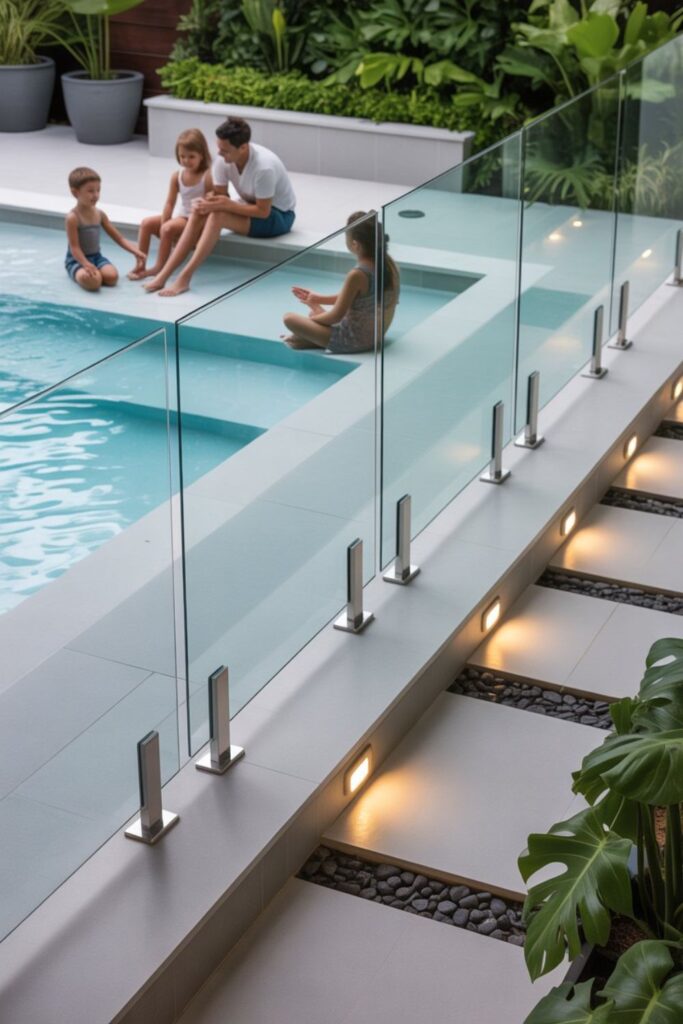
Safety considerations prevent accidents that can turn dream outdoor living spaces into liability nightmares. Proactive measures protect guests while satisfying legal requirements.
Non-slip surfaces throughout pool deck areas reduce fall risks significantly. Specify brushed or textured finishes rather than smooth materials. Seal natural stone to prevent algae growth that creates slick spots. Pressure wash regularly to remove dirt buildup that compromises traction. Install slip-resistant mats at pool entry and exit points where water accumulates most.
Perimeter fencing meets code requirements in most jurisdictions while providing privacy and wind screening. Self-closing, self-latching gates prevent unsupervised child access. Five-foot minimum heights work for most codes though some areas require six feet. Choose attractive fencing that enhances rather than detracts from your poolside patio aesthetics. Glass panels maintain views while providing barriers.
Adequate lighting prevents trips and falls after dark around pool edges. Illuminate stairs, elevation changes, and circulation paths thoroughly. Avoid creating glare on water surfaces that blinds swimmers. Motion sensors activate lights as people approach, conserving energy while ensuring safety. Battery backup systems keep critical safety lights functioning during power outages.
Emergency equipment within easy reach includes life rings, reaching poles, and first aid kits. Mount life-saving devices in visible locations that guests can access quickly. Keep rescue equipment on both sides of pools larger than 30 feet. Post CPR instructions and emergency numbers near pool areas. These precautions might never get used but their presence provides peace of mind.
Slip-resistant pool steps and handrails assist entry and exit safely. Stainless steel rails resist corrosion while providing secure grip points. Position rails on both sides of steps for maximum accessibility. Consider installing additional rails along pool perimeters where elderly guests might swim. These thoughtful additions make your outdoor patio ideas with pool more inclusive.
How to Add Privacy to Your Pool Patio
Privacy screening transforms exposed pool areas into secluded sanctuaries where you can relax without neighbor scrutiny. Strategic barriers block sightlines while improving aesthetics.
Living walls using fast-growing bamboo, Leyland cypress, or arborvitae create natural screens that improve over time. These green barriers absorb noise, filter air, and attract beneficial birds. Plant in staggered rows for faster full coverage. Evergreen varieties maintain privacy year-round unlike deciduous options. Containers work for renters wanting portable solutions.
Lattice panels or decorative screens offer instant privacy that doesn’t require years of growth. Laser-cut metal screens in geometric patterns add modern artistic elements. Wood lattice painted to match your home’s trim integrates seamlessly. Attach climbing plants like jasmine or honeysuckle for living artwork that smells incredible. These vertical features work brilliantly in small backyards where planting beds aren’t feasible.
Cabana curtains or outdoor drapes create flexible privacy that adjusts to your needs. Weather-resistant fabrics hang from tracks mounted to pergola beams. Draw panels closed for intimate gatherings or tie them back when hosting crowds. Sheer fabrics filter light while maintaining airflow. These textiles soften hard poolside surfaces beautifully.
Strategic fencing using horizontal slats or board-on-board designs provides solid screening. Modern horizontal planks create contemporary looks while vertical pickets suit traditional homes. Vary slat spacing to balance privacy with airflow. Darker stain colors recede visually while bright whites make small backyards feel more spacious. Top fences with lighting or planters for finishing touches.
Water features like vertical waterfalls or fountain walls provide acoustic privacy that visual barriers miss. The pleasant sound masks conversations from reaching neighbors. Position water elements between seating areas and property lines for maximum effectiveness. These features double as stunning focal points that elevate your entire pool deck aesthetic.
What Are the Best Plants for Poolside Patios?
Pool landscaping selections must tolerate chlorine spray, high heat reflection, and constant moisture while requiring minimal maintenance. Strategic plantings soften hardscapes without creating debris problems.
Tropical palms deliver instant resort character around outdoor patio ideas with pool. Varieties like sago palm, fan palm, or queen palm thrive in poolside conditions. Their large fronds provide natural shade while making bold architectural statements. Container-grown specimens offer flexibility for seasonal rearrangement or winter protection in cold climates. Palms drop minimal leaves compared to deciduous trees.
Ornamental grasses like fountain grass, blue fescue, or maiden grass add movement and texture without messy flower drop. These low-maintenance plants tolerate reflected heat beautifully. Their fine foliage creates soft contrast against rigid pool coping. Mass plantings in repeating patterns create cohesion around large pool decks. Most varieties require simple annual shearing as only maintenance.
Succulents and cacti suit modern poolside patio designs with their sculptural forms and zero-fuss care. Agave, aloe, and various sedums thrive in hot, dry conditions common around pools. Their thick leaves store water, reducing irrigation needs significantly. These drought-tolerant options work brilliantly for budget-friendly landscapes or water-conscious regions.
Flowering shrubs like hibiscus, oleander, or plumbago provide seasonal color without excessive petal drop. Choose varieties with larger blooms that fall cleanly rather than small flowers that scatter. Position flowering plants away from pool edges where blooms won’t blow into water constantly. These workhorses bloom repeatedly throughout warm seasons with modest maintenance.
Avoid plants with aggressive root systems, deciduous leaf drop, or fruits that stain surfaces. Skip willows, cottonwoods, mulberries, or fruit trees near pools. Their roots invade plumbing while their debris creates constant cleaning. Also eliminate thorny specimens like bougainvillea or roses near barefoot traffic areas. Choose plants that enhance rather than complicate your poolside experience.
How Much Does a Pool Patio Cost to Install?
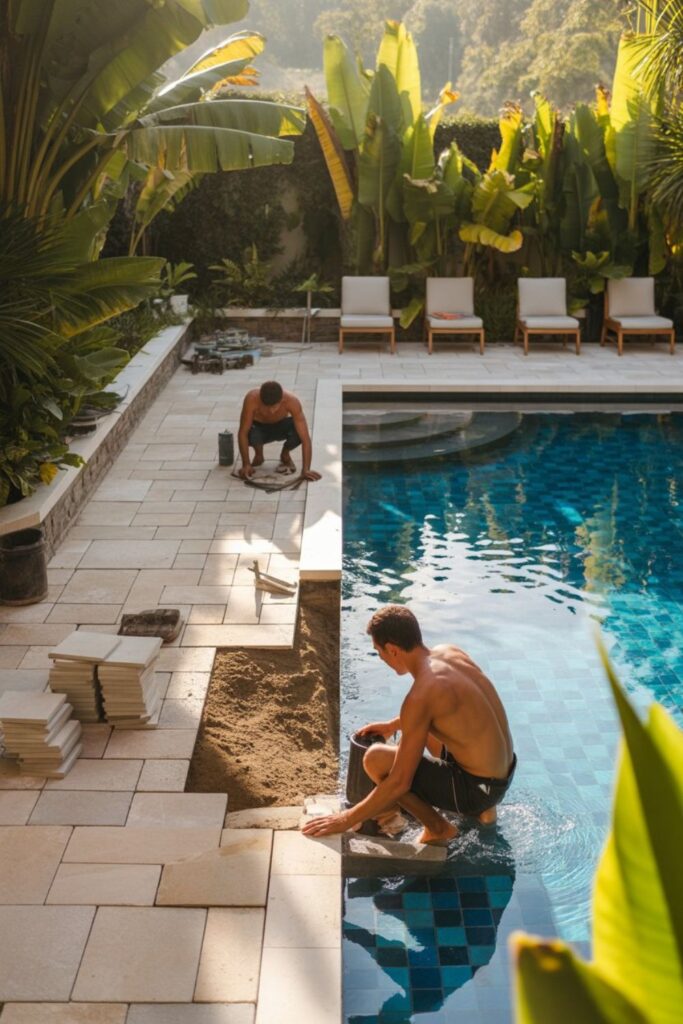
Budget-friendly approaches to outdoor patio ideas with pool range from simple DIY concrete staining to elaborate stone installations exceeding $50,000. Understanding cost factors helps prioritize spending.
Basic concrete pool decks cost $6-10 per square foot for standard broom-finished surfaces. A 600-square-foot deck runs $3,600-6,000 including excavation and pouring. Stamped or stained concrete adds $3-5 per square foot for decorative finishes. These budget-friendly options provide functional surfaces that you can upgrade later with furniture and landscaping.
Concrete pavers average $12-18 per square foot installed around pools. Premium interlocking varieties resist shifting better than standard types. A 600-square-foot paver deck costs $7,200-10,800 complete. Colors and patterns matching your home’s architecture create cohesive designs. These mid-range materials balance aesthetics with affordability effectively.
Natural stone like travertine or bluestone commands $20-35 per square foot installed. A 600-square-foot luxury pool deck runs $12,000-21,000 for materials and labor. Add another $8,000-15,000 for features like built-in lounge areas, waterfalls, or outdoor kitchens. These premium poolside patio designs rival resort quality but require substantial investment.
Pergolas range from $3,000 for simple DIY kits to $15,000+ for custom structures with lighting and fans. Retractable awnings cost $1,500-4,000 depending on size and automation. Lighting systems run $2,000-8,000 for complete installations with underwater, patio, and landscape fixtures. Furniture budgets vary wildly from $2,000 for basic sets to $20,000+ for high-end teak or synthetic wicker collections.
Professional installation versus DIY projects impacts total costs significantly. Hiring contractors for entire pool deck renovations typically doubles material costs. However, professional work includes warranties, proper drainage, and code compliance. Consider DIY for simple projects like furniture placement or container gardens while leaving complex hardscaping to experts.
What Outdoor Furniture Works Best Around Pools?
Patio furniture selections for poolside areas must withstand moisture, chlorine exposure, and UV rays while providing comfort. Materials matter more than aesthetics for longevity.
Aluminum frames with synthetic wicker weaving dominate pool deck ideas because they’re rust-proof, lightweight, and stylish. Quality resin wicker mimics natural materials while resisting moisture damage. Powder-coated aluminum frames never corrode even with constant splash exposure. Cushions should feature quick-dry foam cores with solution-dyed acrylic covers that resist fading and mildew.
Marine-grade teak furniture ages beautifully into silvery gray patinas if left untreated. This premium hardwood contains natural oils that repel water and insects. Teak never splinters, warps, or rots even in constant moisture. Initial costs exceed other options significantly but the investment lasts generations. Alternatively, apply teak sealers annually to maintain honey tones.
Plastic resin lounge chairs offer budget-friendly functionality perfect for heavy-use pool areas. Modern designs have evolved beyond cheap white versions from decades past. Today’s recycled plastic furniture comes in designer colors and ergonomic shapes. These lightweight pieces store easily and clean with simple hosing. Replace them every 5-7 years as styles or needs change.
Stainless steel and mesh furniture suits contemporary poolside patio aesthetics with industrial flair. Perforated metal seats drain instantly after rain or splashing. These sleek pieces work beautifully in small backyards where visual weight matters. Marine-grade stainless resists corrosion better than standard types. Add thin cushions for comfort without permanent fabric installations.
Avoid wrought iron, untreated wood, or fabric-heavy pieces near pools. Iron rusts rapidly despite protective coatings once moisture penetrates. Untreated wood mildews, warps, and requires constant maintenance. Thick fabric cushions that don’t drain properly develop mold within weeks. Choose materials specifically engineered for outdoor living spaces exposed to water.
Read More About: 47+ Outdoor Patio Ideas on a Budget That Look Expensive
How to Create an Outdoor Kitchen by Your Pool
Outdoor kitchens elevate pool areas from recreational spaces into full entertainment zones. Self-sufficient cooking areas prevent constant trips indoors during parties.
Essential appliances include built-in grills, refrigerators, and sinks for complete functionality. Stainless steel components resist corrosion from chlorine-laden air surrounding pools. Natural gas connections provide consistent fuel without propane tank swaps mid-party. Infrared burners deliver restaurant-quality searing. Include prep counters on both sides of grills with minimum 24-inch widths for workspace.
Covered structures over outdoor kitchens protect equipment while allowing year-round use. Extend your home’s roofline or build dedicated pavilions with proper ventilation. Ceiling-mounted heaters and fans control temperatures across seasons. Weatherproof cabinetry stores plates, utensils, and serving pieces. Marine-grade materials prevent maintenance headaches common with standard indoor products exposed outdoors.
Bar seating facing pools creates social spaces where cooks interact with swimmers. Mount counters at 42-inch heights with 24-inch overhangs accommodating barstools. Include electrical outlets every 4 feet for blenders, phone charging, or decorative lighting. Foot rails provide comfort during extended gatherings. These interactive zones keep parties flowing naturally.
Refrigerated storage keeps beverages cold without sacrificing lounge space for clunky coolers. Under-counter outdoor refrigerators or beverage centers hold 100+ cans. Some models include dual temperature zones for wine and beer. Locking doors prevent unauthorized access when pools host neighborhood kids. Built-in ice makers eliminate bag-buying entirely.
Budget-friendly alternatives to full outdoor kitchens include rolling carts with portable grills and mini-fridges. These flexible solutions cost under $2,000 versus $15,000+ for permanent installations. Store components during winter or move them for furniture rearrangements. Upgrade gradually as budgets allow by adding built-in elements over time.
What Maintenance Do Pool Patios Require?
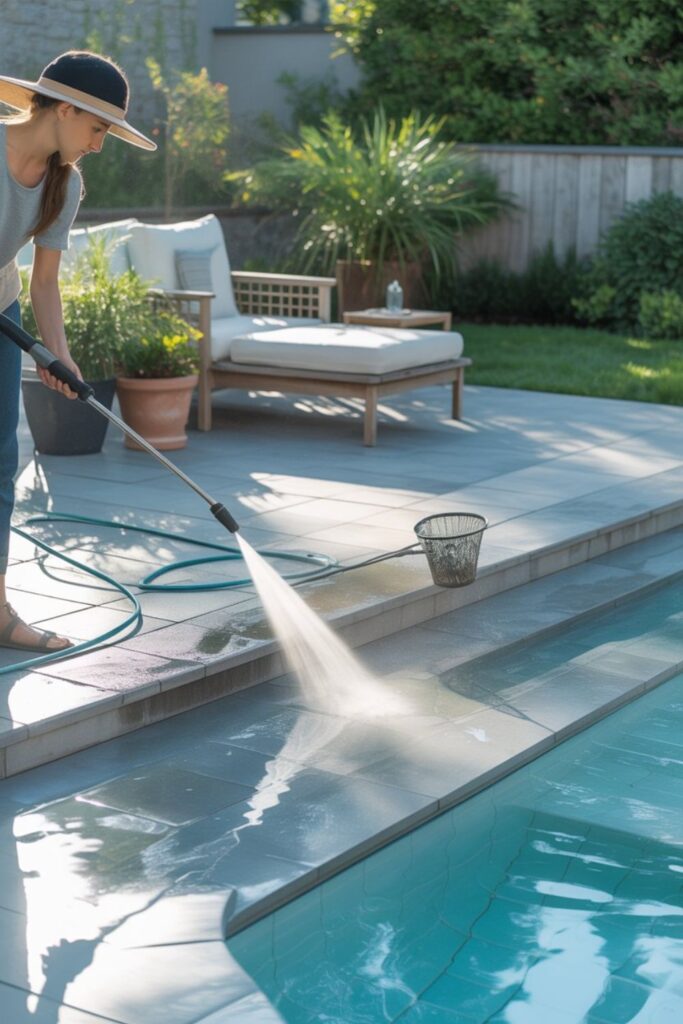
Regular maintenance preserves poolside patio surfaces and prevents expensive repairs. Seasonal attention addresses specific challenges facing outdoor living spaces around water.
Daily skimming removes leaves, insects, and debris before they stain surfaces or clog drains. Use leaf blowers on pool decks each morning during heavy fall leaf drop. Spot-clean spills immediately since sunscreen, food, and beverages can discolor materials if left sitting. Rinse chlorinated water splashes from furniture and plantings to prevent damage.
Weekly pressure washing keeps pool decks looking fresh while preventing algae buildup. Use appropriate pressure settings for your surface materials to avoid etching damage. Clean furniture cushions monthly with mild soap solutions. Inspect lighting fixtures for burnt bulbs or moisture intrusion. Trim overhanging vegetation that drops debris constantly.
Seasonal deep cleaning includes resealing natural stone or pavers every 2-3 years. This protective layer maintains water resistance and color vibrancy. Pressure wash before applying sealers for proper adhesion. Inspect drainage systems for clogs that could cause flooding during heavy rains. Lubricate furniture moving parts and tighten hardware loosened by constant use.
Winter preparation in cold climates means storing cushions and covering furniture with weatherproof tarps. Drain fountains and water features to prevent freeze damage. Remove snow promptly from pool decks using plastic shovels that won’t scratch surfaces. Skip salt-based deicers that damage stone and concrete; use sand for traction instead.
Chemical balance in pools affects surrounding patios significantly. Maintain proper pH and chlorine levels to minimize corrosive splashing. Test water weekly and adjust chemicals as needed. Over-chlorinated water bleaches patio furniture fabrics and accelerates material deterioration. Proper balance protects your entire investment.
What Are the Latest Trends in Pool Patio Design?
Current outdoor patio ideas with pool emphasize seamless indoor-outdoor transitions and smart technology integration. Modern homeowners expect resort-level amenities in residential settings.
Infinity edges and vanishing borders create visual continuity between pools and surrounding landscapes. These architectural features make water appear to merge with distant horizons. Negative-edge pools overflow into hidden catch basins for dramatic effects. The technique works spectacularly on sloped properties with valley views. Expect premium costs for engineering and construction complexity.
Smart automation systems control pool equipment, lighting, fountains, and music through single apps. Program settings for daily operations or special events with button presses. Voice control integration with Alexa or Google Home adds convenience. Water temperature, chemical levels, and filter cycles all monitor remotely. These technologies provide luxury without constant manual adjustments.
Natural swimming pools using biological filtration instead of chemicals gain popularity among eco-conscious homeowners. Regeneration zones with aquatic plants clean water naturally. These organic systems eliminate chlorine irritation and harsh chemical smells. The aesthetic mimics natural ponds with rock surrounds and native landscaping. Costs exceed traditional pools but environmental benefits appeal to sustainability-focused owners.
Multi-level pool deck designs create distinct zones at varying elevations. Raised platforms separate dry lounge areas from wet circulation spaces. Steps and retaining walls add architectural interest to flat yards. These dimensional layers make small backyards feel more spacious through visual tricks. Include built-in seating along elevation changes for maximized utility.
Fire and water combinations deliver dramatic focal points with elemental contrasts. Fire pit tables positioned beside pools create year-round gathering spots. Fire bowls mounted on pool walls or floating features provide stunning nighttime ambiance. These bold design choices photograph beautifully for social media while providing genuine functional value. Modern gas systems offer convenience and safety over traditional wood-burning options.
Frequently Asked Questions
How much space do I need between my pool and patio furniture?
Maintain minimum 4-foot clearances between pool edges and furniture to prevent splash damage to cushions and allow safe circulation. Lounge areas work best 10-15 feet from water where guests can relax without constant wetness. High-traffic paths need 6-8 foot widths for comfortable group movement without bottlenecks.
What is the most slip-resistant material for pool decks?
Textured travertine and brushed concrete provide excellent traction when wet. Avoid polished stone, glazed tile, or smooth concrete finishes. Pebble surfaces using exposed aggregate offer superior grip. Always test materials by wetting samples and walking barefoot before purchasing. Non-slip ratings should exceed 0.6 coefficient values for safety.
Can I build a patio around an existing pool?
Absolutely! Retrofitting outdoor patio ideas with pool integration around existing structures represents the most common scenario. Remove old concrete, ensure proper drainage slopes, and install new surfaces. Consider this opportunity to upgrade lighting, add shade structures, or improve landscaping simultaneously. Professional contractors handle these renovations regularly.
How do I prevent pool chemicals from damaging my patio?
Choose chlorine-resistant materials like sealed stone, quality pavers, or treated concrete. Rinse pool decks regularly to remove chemical residue before it concentrates. Maintain proper water chemistry to minimize corrosive splashing. Avoid wood furniture or unsealed surfaces that absorb chemicals. Reapply sealers every 2-3 years for continued protection.
What lighting is safest around pools?
Use only low-voltage LED systems specifically rated for wet locations around pool areas. Underwater fixtures must meet UL certification standards for submersion. Keep electrical outlets and switches minimum 6 feet from water edges. Install ground fault circuit interrupters on all poolside electrical circuits. Consult licensed electricians for code-compliant installations.
How can I make my small pool patio look bigger?
Use light-colored materials that reflect rather than absorb light. Extend patio surfaces into lawn areas with steppers for visual continuity. Minimize furniture pieces to essential items only. Vertical gardens draw eyes upward while mirrors create depth illusions. Strategic lighting after dark expands perceived boundaries significantly in small backyards.
Conclusion
Transforming your property with comprehensive outdoor patio ideas with pool integration creates cohesive entertainment zones that rival resort destinations. The key lies in balancing functionality with aesthetics while prioritizing safety and maintenance considerations. Start with proper planning that addresses drainage, circulation patterns, and activity zones before selecting materials. Choose non-slip surfaces appropriate for your climate and budget while incorporating comfortable furniture, strategic lighting, and thoughtful landscaping that makes your poolside patio genuinely inviting year-round.
The most successful pool deck designs evolve gradually rather than attempting perfection immediately. Begin with essential infrastructure like quality surfaces and basic seating, then layer features such as outdoor kitchens, cabanas, or sophisticated lighting systems as resources allow. Your outdoor living space should adapt to changing needs and growing budgets over time. Take action today by assessing your current pool area, identifying priority improvements, and researching materials that appeal to your aesthetic. Every exceptional poolside patio started as someone’s vision that they committed to making reality, and your backyard deserves that same dedication to creating memories.


